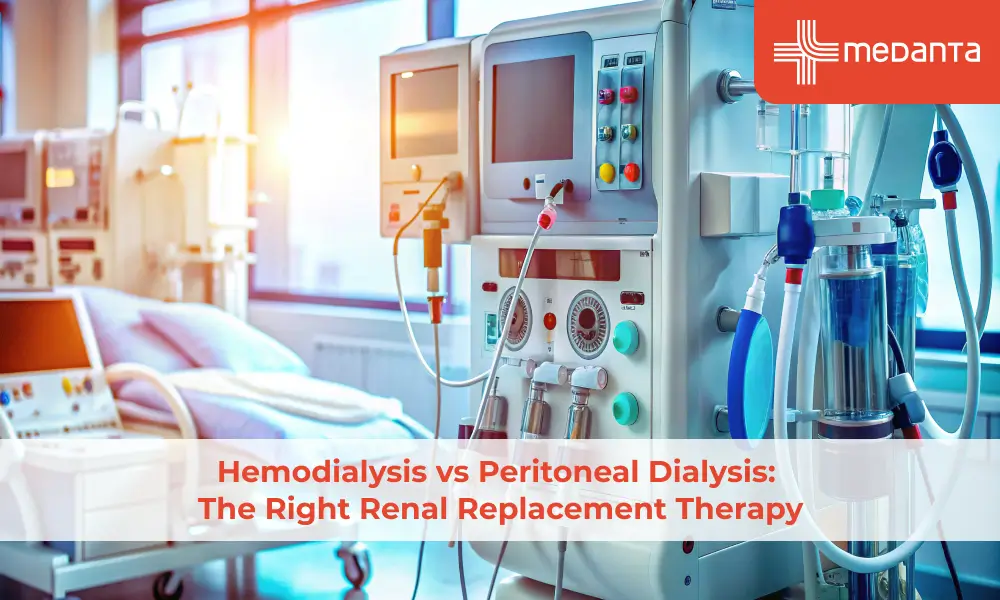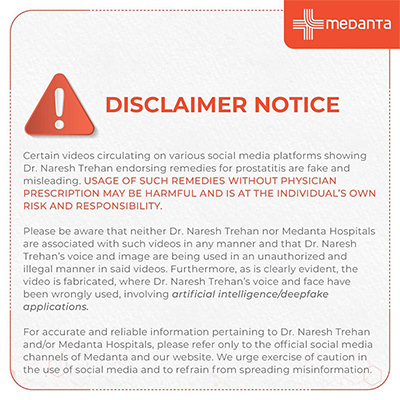Hemodialysis vs Peritoneal Dialysis: The Right Renal Replacement Therapy

TABLE OF CONTENTS
Your kidneys help remove waste, excess salt, and fluids from your body. However, if your kidney fails, whether due to chronic kidney disease or any other reason, the organ becomes incapable of working properly and performing essential functions. In such a case, renal replacement therapy might become a vital necessity.
But before kidney replacement treatment, your doctor might recommend that you be on dialysis. Now, the question arises whether to go for hemodialysis or peritoneal dialysis. Both these serve as life-sustaining treatments.
This article will educate you about both types of dialysis. You will understand the differences between hemodialysis and peritoneal dialysis, guiding you in making an informed decision based on your kidney condition and lifestyle.
What is Hemodialysis?
Hemodialysis involves an external machine helping get rid of waste, salts, and fluids from your blood. This entire 3-5 hours long process entails drawing blood from your body, passing it through a dialyser (artificial kidney) so that it can filter it, and then returning the cleansed blood to your body. You can choose to undergo hemodialysis in a hospital, your home, or a dialysis centre.
What is Peritoneal Dialysis?
A home-based dialysis procedure, peritoneal dialysis involves using the lining of your abdomen, known as the peritoneum, to filter blood inside your body. Two ways are usually followed to perform peritoneal dialysis:
Continuous Ambulatory Peritoneal Dialysis, which can be done manually.
Automated Peritoneal Dialysis, which uses a machine (cycler).
What You Can Expect from Hemodialysis?
Weeks before hemodialysis begins, patients undergo a minor surgery to create a vascular access point. They might have an:
Arteriovenous fistula wherein a surgeon joins an artery and vein.
Arteriovenous graft wherein artery and vein are joined using a synthetic tube.
It’s done to enlarge the connected artery and vein, helping your blood flow in and out of your body seamlessly and quickly.
Now, actual hemodialysis is performed, wherein the dialysis machine:
Draws blood from the vascular access point in your arm via a needle.
Pass your blood through the dialyser filter, which moves waste products, excess salts, and fluids into a dialysis solution containing water, salt, and other additives.
Returns the clean blood to your body via the vascular access point using a different needle.
Monitors your blood pressure so that it can adjust how fast your blood is flowing in and out of your body.
Once you are done with your hemodialysis, you might experience the following side effects:
Low blood pressure
Chest or back pain
Nauseousness or dizziness
Headaches
Muscle cramps
Faint
Itchy skin
Restless legs syndrome
What You Can Expect from Peritoneal Dialysis?
Patients have a surgical procedure approximately three weeks before they undergo peritoneal dialysis. During this dialysis procedure, your surgeon will insert a catheter (soft, thin tube) into your peritoneum through your belly. Also, note that this catheter will permanently stay in this place.
Next, your healthcare professional will train you or your caregivers on performing peritoneal dialysis, maintaining hygiene, and managing the equipment to avoid infections at the catheter site.
Here’s what you need to do during peritoneal dialysis:
Connect the catheter to any one branch of a Y-shaped tube, which is further connected to a bag containing a dialysis solution called dialysate. This solution will flow through the tube and catheterise into your peritoneal cavity.
You need to disconnect the catheter and tube after around 10 minutes as soon as the bag is empty.
Cap off the catheter, and the cleansing fluid will itself absorb waste products and excess fluids from your body in about 60 to 90 minutes.
Finally, it’s time to remove the cap from the catheter and use the Y-shaped tube’s other branch to drain the fluid into a clean, empty bag.
You need to repeat these steps four times a day. After peritoneal dialysis, your belly might feel bloated or full. Don’t worry, it’s completely normal.
Hemodialysis vs Peritoneal Dialysis: Knowing the Difference
Go through this table to learn the difference between these two types of dialysis:
Basis of Difference | Hemodialysis | Peritoneal Dialysis |
Treatment Environment | Performed in a dialysis centre under professional supervision, though it can also be done at home | Performed at home |
Frequency and Duration | Usually performed three sessions per week, each for 3-5 hours | Need to be done daily 4-5 times a day |
Infection Risk | The vascular access site can be infected | Higher risk of peritonitis due to the catheter in the abdomen |
Impact on Lifestyle | Patients might need strict scheduling, and it can disrupt their daily lives due to the long hours needed for treatment | Offers greater flexibility, allowing patients to continue with daily activities with minimal disruption |
Dietary Restrictions | More stringent dietary restrictions to manage fluid and electrolyte levels | Fewer dietary restrictions since it is a continuous process |
Which is Better: Hemodialysis vs Peritoneal Dialysis?
Whether you opt for hemodialysis or peritoneal dialysis, both will provide effective results. You should consider your medical condition, kidney function, lifestyle, personal preference, home situation, and the ability to manage treatment when deciding between these dialysis procedures.
If you have less kidney function and require close medical supervision or are unable to perform dialysis on your own, undergoing hemodialysis can be the better option for you. On the other hand, peritoneal dialysis is ideal for patients seeking flexibility and those who can manage their care independently. Other than that, you should also know that peritoneal dialysis isn’t a suitable option for obese individuals or those who have abdominal scarring.
To wrap it all up!
Both hemodialysis and peritoneal dialysis can effectively manage kidney failure and improve the outcome of a kidney replacement treatment. But their processes, advantages, and impacts on daily life differ significantly. So, you should know them all to make the best choice for your renal replacement therapy.
Confused between hemodialysis and peritoneal dialysis? Schedule a consultation with the Medanta renal care department to understand these two dialysis procedures and which will best suit your medical condition, health, and overall lifestyle.






